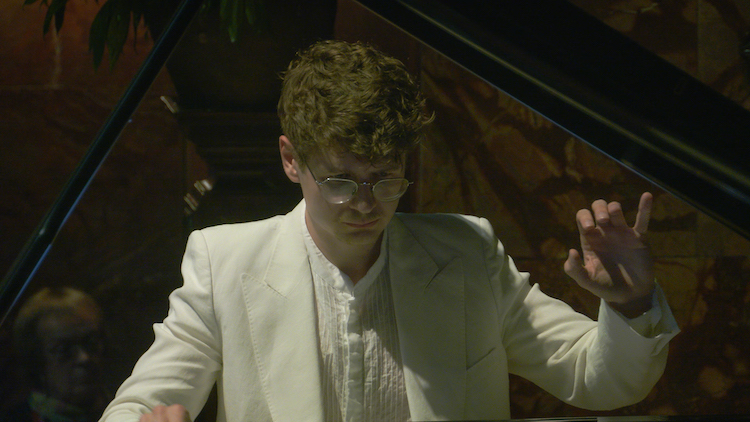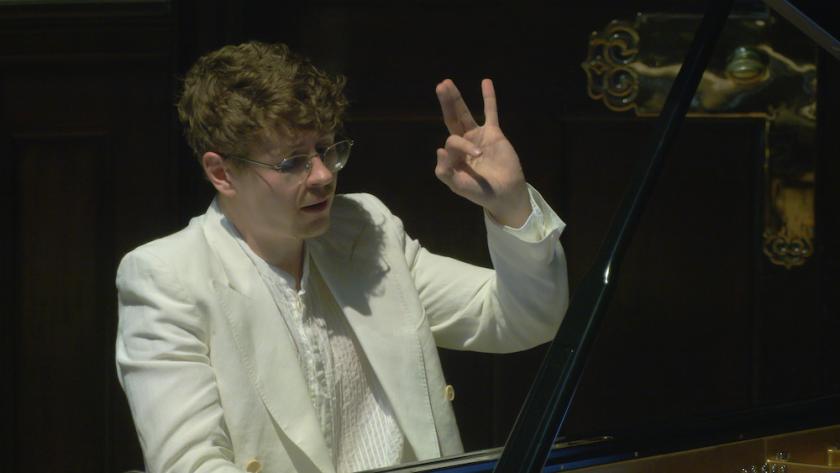Like his baggy white suit, pitched somewhere between Liberace and Colonel Sanders, Pavel Kolesnikov’s playing was spotless at the Wigmore Hall last night. It comprised two very different halves, the first a miscellany of apparently unrelated pieces, the second devoted to a single set of pieces by a single composer. Both parts worked wonderfully, and made a very satisfying whole, the overlong Philip Glass encore the only misjudgement of the evening.
The American artist Joseph Cornell (1903-72) assembled disparate everyday objects in a glass-fronted box in his work Celestial Navigation, which gave the concert its title. In Kolesnikov’s case, the jumble of items in the first half embraced Louis Couperin, Chopin and Messiaen, in a single unbroken sequence of piano music that dazzled, delighted and seemed to flash past. As can happen when this kind of programme is well put together, each item informed the others, throwing up unlikely points of connection and consanguinity.
For example, I wouldn’t have felt there was much in common between Ravel and Messiaen, one all elegance and urbanity, the other all muscular Christianity. But once you put aside the difference in harmonic language, the flourishes and arabesques of “Une barque sur l’océan” from Ravel’s Miroirs and “Regard de l’Etoile” from Messiaen’s Vingt regards sur l’Enfant-Jésus are cut from the same cloth. Likewise the flowing, improvisatory melodic lines of Chopin’s Nocturne op.27 no.2 have a kinship with Louis Couperin’s florid Pavane in F-sharp minor. Indeed the Couperin was one of the big highlights, a substantial opener that covered a lot of emotional ground, in which Kolesnikov explored a huge dynamic range, starting with a robustness that melted into almost nothing in the last bars. He had the courage to play very quietly, and the audience rewarded him by listening intently. He hummed along, Glenn Gould style, and grooved like a jazzer in places, uncovering things in the music that Couperin himself wouldn’t have dreamed of. I loved it.
Indeed the Couperin was one of the big highlights, a substantial opener that covered a lot of emotional ground, in which Kolesnikov explored a huge dynamic range, starting with a robustness that melted into almost nothing in the last bars. He had the courage to play very quietly, and the audience rewarded him by listening intently. He hummed along, Glenn Gould style, and grooved like a jazzer in places, uncovering things in the music that Couperin himself wouldn’t have dreamed of. I loved it.
Kolesnikov got the volcanic changes of mood in the various Messiaen pieces (there were four, some repeated) and reminded me both how much I enjoy listening to Messiaen but also how infrequently he seems to get programmed. He is also perhaps a composer heard best in small doses – after a while some of his tics become clichés – another reason this programme worked.
The first half came to an end with Thomas Adès’s astonishing Darknesse Visible, written when he was only 21, a “deconstructed” Dowland lute-song, like a “deconstructed banoffee pie” on a Masterchef plate. The lute is there in the ubiquitous single-note tremolos, which are such a test of piano technique. Around them the notes of the melody are dispersed across the range of the keyboard in disjointed, abrupt gestures. Only at the very end, and very briefly, does the song emerge recognisably, in a tantalising, and highly moving, ending. Kolesnikov gave it pathos by not indulging the pathos, the final unresolved note hanging forever in the air.
The second half was simpler in conception but just as enjoyable, continuing the thread of improvisation that ran through the whole evening. Schubert’s D.935 set of Impromptus are big-boned and varied, from the stern rhetoric of the first, through the wonderful melodic effusions of the middle two, to the rhythmic games of the fourth. Kolesnikov was as good in capturing the broad architecture of number one as he was in the later flighty theme and variations. The last movement, with its mock-fiery outbursts, is a brilliant example of Schubert’s musical wit, and Kolesnikov was in on the joke.














Add comment